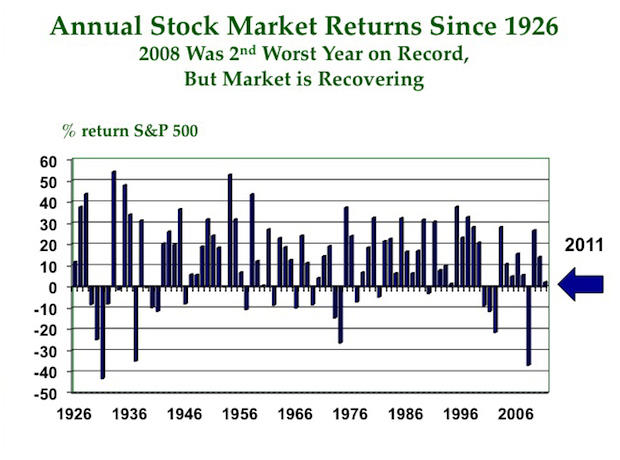Stock market returns offer reason for optimism
Each year I update a chart that shows the annual percentage returns in the S&P 500 for every year since 1926. Below you'll see the version through the end of 2011. This chart provides a good visual of what I call the stock market "double-double." The returns shown here include both capital gains and losses, as well as dividends.
If you look closely at the chart, you'll see that there are approximately twice as many up years as down. That's part one of the double-double. Here's part two: The up bars go up about twice as high as the down bars go down, meaning that when the market went up, you usually made more money than you lost when the market went down.

Note that 2008 was the second-worst year on record. If you believe that the stock market will come back from its big drop in 2008, you have history on your side -- you just have to wait for the up years to return. So far, 2009, 2010 and 2011 have given us hope. Although the market's return for 2011 was just over 2 percent, at least it's still positive and headed in the right direction.
This chart also provides evidence that we're not in the territory of the Great Depression, at least as of yet. The worst year on record -- 1931 -- was preceded by two down years and was also followed by a down year. So far, 2008 is surrounded by up years.
For most of us, our retirement investing horizon gives us the time to ride out the downturns. It particularly helps if you build complementary sources of retirement security that aren't susceptible to market fluctuations, which I highly encourage you to do.
Why you need to diversify your retirement income
Study: 401(k) investors who stayed the course in 2008-09 were big winners
I'd also encourage you not to go whole hog and invest too much in stocks. A diversified portfolio of stocks, bonds, cash and possibly real estate has proven to provide adequate protection against the extremes of downturns and inflation, while also providing a return that should be sufficient to finance your retirement years. Additionally, most diversified portfolios have recovered to exceed their pre-crash highs, which bolsters the case for using a balanced portfolio.
Take the long view and have the patience to let the stock market "double-double" work for you.
Steve Vernon
View all articles by Steve Vernon on CBS MoneyWatch»
Steve Vernon helped large employers design and manage their retirement programs for more than 35 years as a consulting actuary. Now he's a research scholar for the Stanford Center on Longevity, where he helps collect, direct and disseminate research that will improve the financial security of seniors. He's also president of Rest-of-Life Communications, delivers retirement planning workshops
and authored Retirement Game-Changers: Strategies for a Healthy, Financially Secure and Fulfilling Long Life and Money for Life: Turn Your IRA and 401(k) Into a Lifetime Retirement Paycheck.
Disclaimer: The copyright of this article belongs to the original author. Reposting this article is solely for the purpose of information dissemination and does not constitute any investment advice. If there is any infringement, please contact us immediately. We will make corrections or deletions as necessary. Thank you.







